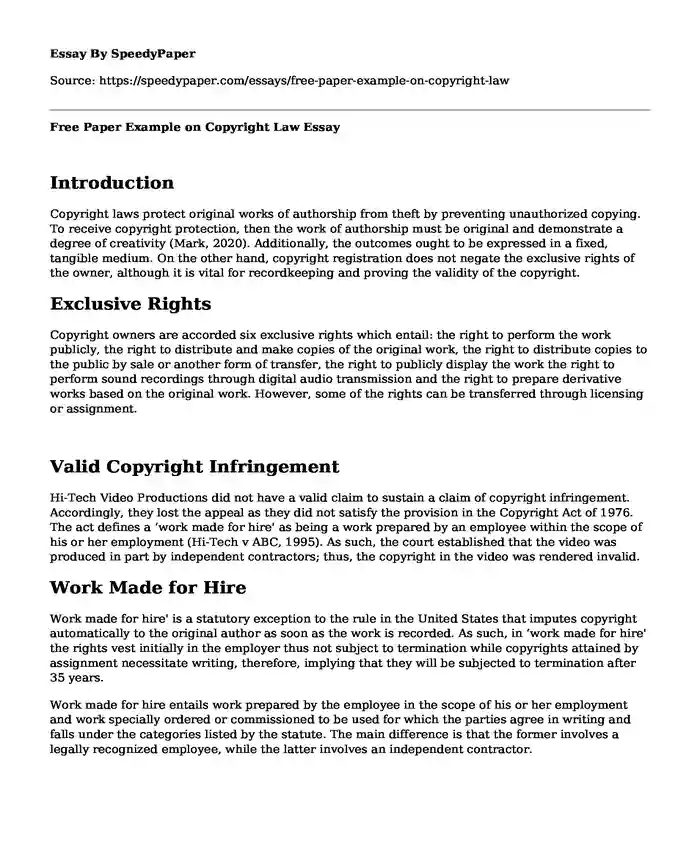
| Type of paper: | Essay |
| Categories: | Law |
| Pages: | 3 |
| Wordcount: | 712 words |
Introduction
Copyright laws protect original works of authorship from theft by preventing unauthorized copying. To receive copyright protection, then the work of authorship must be original and demonstrate a degree of creativity (Mark, 2020). Additionally, the outcomes ought to be expressed in a fixed, tangible medium. On the other hand, copyright registration does not negate the exclusive rights of the owner, although it is vital for recordkeeping and proving the validity of the copyright.
Exclusive Rights
Copyright owners are accorded six exclusive rights which entail: the right to perform the work publicly, the right to distribute and make copies of the original work, the right to distribute copies to the public by sale or another form of transfer, the right to publicly display the work the right to perform sound recordings through digital audio transmission and the right to prepare derivative works based on the original work. However, some of the rights can be transferred through licensing or assignment.
Valid Copyright Infringement
Hi-Tech Video Productions did not have a valid claim to sustain a claim of copyright infringement. Accordingly, they lost the appeal as they did not satisfy the provision in the Copyright Act of 1976. The act defines a ‘work made for hire' as being a work prepared by an employee within the scope of his or her employment (Hi-Tech v ABC, 1995). As such, the court established that the video was produced in part by independent contractors; thus, the copyright in the video was rendered invalid.
Work Made for Hire
Work made for hire' is a statutory exception to the rule in the United States that imputes copyright automatically to the original author as soon as the work is recorded. As such, in ‘work made for hire' the rights vest initially in the employer thus not subject to termination while copyrights attained by assignment necessitate writing, therefore, implying that they will be subjected to termination after 35 years.
Work made for hire entails work prepared by the employee in the scope of his or her employment and work specially ordered or commissioned to be used for which the parties agree in writing and falls under the categories listed by the statute. The main difference is that the former involves a legally recognized employee, while the latter involves an independent contractor.
Fair Use
Fair use is a doctrine that is intended to protect the right of reasonable public access for specific limited purposes to works that are copyrighted. There is a bright line for the application of this exception which factors in four considerations that determine whether the use is fair.
Four Factors
The first factor encompasses the purpose and character of the use. It assesses whether the goal is commercial or non-profit educational purposes. The general rule being that the copyright holder should be the sole beneficiary, thus asserting that commercial uses are unfair (Stephen, 2018). Additionally, non-profit education uses are considered fair use.
Secondly, the law allows access to both published and unpublished materials as it aims to not only benefit the author but also to promote progress through creativity.
Thirdly, the amount and substantiality of the portion used to copyright work. Since the law does not provide for a limit to the number of words, the focus is whether the amount used exceeds the necessity to achieve a protected purpose.
Lastly is the effect of the use on the market value of the copyrighted work. This assesses whether a person's use deprives the copyrighted owner of commercial benefit or whether it undermines the potential market for the copyrighted work.
Conclusion
Copyright law protects works made by individuals during their lifetime and an additional seventy years after the author of the book dies. Copyright is personal property allows for the transfer to the kin or a third party via a will when the owner dies.
Before deciding a dispute, a court needs to satisfy itself that it has jurisdiction over the dispute. This jurisdiction entails the subject matter and personal jurisdiction.
References
Brown, Mark. (2018, 6 3). An Introduction to Property Law. MARCARIA. Retrieved from https://www.marcaria.com/ws/en/articles/introduction-to-copyright-lawHi Tech Video Productions V ABC inc 35USPQ2D 1995
Gillen, S. (2018). The Fair Use Defence. In Guide To RIGHT Clearance & Permissions (26). U.S: TAA.
Gillen, S. (2018). The Work-for-Hire Minefield. IBPA, 1(1), 23-25.
Cite this page
Free Paper Example on Copyright Law. (2023, Nov 24). Retrieved from https://speedypaper.com/essays/free-paper-example-on-copyright-law
Request Removal
If you are the original author of this essay and no longer wish to have it published on the SpeedyPaper website, please click below to request its removal:
- Argumentative Essay Sample: Guns Should Be Controlled
- Essay Sample: International Criminal Court Pros and Cons
- Free Paper: Areas of Development in the Current UAE Legislations
- Essay Sample on Ergonomics Assessment in the Manufacturing Industry
- Essay Sample on Root Causes of Low Crimes Resulting in Capital Punishments
- Sentencing Goals: Vengeance, Convalescence, & More - Essay Sample
- Essay Sample. Bank Cards and Account Numbers
Popular categories




